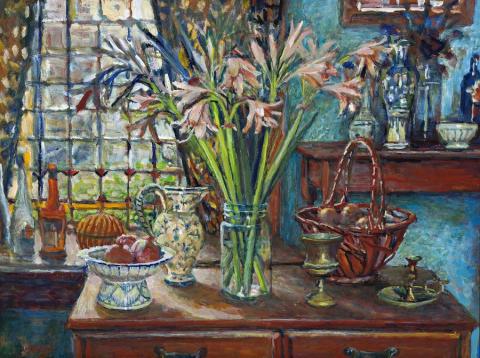HIPPEASTRUMS WITH BRASS ORNAMENT, 2001
MARGARET OLLEY
oil on composition board
69.0 x 92.0 cm
signed lower left: OLLEY
Eva Breuer Fine Art, Sydney (label attached verso)
Private collection, Sydney
Pearce, B., Margaret Olley, The Beagle Press, Sydney, 2012, p. 176, (illus.)
The very warmth of Margaret Olley's famed Paddington home and studio emanates from Hippeastrums with Brass Ornament, 2001, resulting in a visual feast of texture and colour. Here shades of blue and brown innocuously dominate the painting as the sunlight shines through the window, bathing the room in a muted glow and casting theatrical shadows on the various objects that catch the eye. At first glance there is the general appearance that Olley has simply walked into a room and depicted the items exactly as she found them, however as we study the work it becomes evident that each objet d'art has been placed in its position to fulfil a certain role. Olley is a master of spatial placement, a device she acquired from her days working in the theatre, experiencing firsthand the significance of space. As she watched the actors enter the stage and wait 20 seconds before they spoke their lines, Olley was struck by the space that each actor created.1 This 'orchestration' is evident in all of her paintings as each object possesses its own personal atmosphere, proportionate to the composition and as actors of her visual stage.
Olley is renowned for her captivating still-life and interior scenes, as each flower and vase is painted with the same deference as she would paint a human figure. Taking centre stage, the lush hippeastrums demonstrate Olley's love for flora, as she herself has expressed: 'I can feel for flowers as I can for people. Painting flowers is almost like painting a portrait. I couldn't care less about them as botanical specimens - in fact I don't know the names of many of the flowers I paint.'2 This is an intimate scene taken from Olley's everyday life, as if we have stumbled into her private domain. It has been said many times that Olley's domestic environment was her great inspiration, as her good friend Barry Humphries describes, 'the house is her studio, and its contents are her subject. Her method - seemingly vagrant - is in reality a sophisticated artistic assembly line from which emerge her vibrant tableaux of inanimate things.'3
1. Pearce, B., Margaret Olley, Art Gallery of New South Wales, Sydney, 1997, p. 14
2. Olley in The Australian, 10 November 1964, quoted in Pearce, B., Margaret Olley, Art Gallery of New South Wales, Sydney, 1997, p. 76
3. Humphries, B., 'A Note of Exclamation,' in Pearce, B., Margaret Olley, Art Gallery of New South Wales, Sydney, 1997, p. 8
CASSI YOUNG
